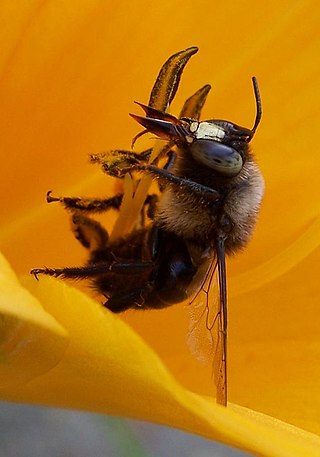
Carpenter bees are species in the genus Xylocopa of the subfamily Xylocopinae. The genus includes some 500 bees in 31 subgenera. The common name "carpenter bee" derives from their nesting behavior; nearly all species burrow into hard plant material such as dead wood or bamboo. The main exceptions are species in the subgenus Proxylocopa; they dig nesting tunnels in suitable soil.

Amegilla is a large genus of bees in the tribe Anthophorini. The genus occurs all around the world, but very few live above 45° North. Amegilla are associated with arid and subarid biomes, matorrals, steppes, sub-deserts and deserts.

Allodapula is a genus of bees in the family Apidae, subfamily Xylocopinae. They are similar in appearance, around 7mm in length, with swarthy head and thorax, contrasting with the brown abdomen. After the removal of a number of former species into other genera, the genus as presently defined occurs only in Africa.

Tetragonula is a genus of stingless bees. In 1961, Brazilian bee expert J.S. Moure first proposed the genus name Tetragonula to improve the classification system by dividing the large genus Trigona stingless bees into 9 smaller groups. About 30 stingless bee species formerly placed in the genus Trigona are now placed in the genus Tetragonula. These bees are found in Oceania, in countries such as Australia, Indonesia, New Guinea, Malaysia, Thailand, the Philippines, India, Sri Lanka, and the Solomon Islands. The most recent tabulation of species listed 31 species.

Epeolus is a genus of cuckoo bees of the tribe Epeolini, the subfamily Nomadinae part of the honey bee family Apidae. They are often known as variegated cuckoo-bees.

Habropoda is a genus of anthophorine bees in the family Apidae. There are at least 50 described species in Habropoda.

Ashmeadiella is a genus of bees in the family Megachilidae. There are more than 60 described species in Ashmeadiella.

Dieunomia is a genus of sweat bees in the family Halictidae. There are about nine described species in Dieunomia.

Anthidiellum is a genus of rotund resin bees in the family Megachilidae. There are more than 60 described species in Anthidiellum.

Rophitinae is a subfamily of sweat bees in the family Halictidae. There are about 13 genera and more than 260 described species in Rophitinae.

Brachynomada is a genus of cuckoo bees in the family Apidae. There are about 17 described species in Brachynomada.

Xenoglossa is a genus of large squash bees in the family Apidae. There are about 11 described species in Xenoglossa.

Anthophorula is a genus of bees in the family Apidae. There are more than 60 described species in Anthophorula.
Oreopasites is a genus of cuckoo bees in the family Apidae. There are about 11 described species in Oreopasites.
Calliopsis puellae is a species of bee in the family Andrenidae. It is found in Central America and North America.

Ancylandrena is a genus of mining bees in the family Andrenidae. There are about five described species in Ancylandrena.

Xeralictus is a genus of sweat bees in the family Halictidae. There are at least three described species in Xeralictus.

Panurginus is a genus of bees in the family Andrenidae. There are more than 50 described species in Panurginus.

Xylocopa tabaniformis, the horsefly-like carpenter bee or mountain carpenter bee is a species of carpenter bee in the family Apidae. It is found in Central America, North America, and South America. It is 12–18 millimetres long and black. Males have yellow hair on the thorax.

Dianthidium curvatum is a species of bee in the family Megachilidae. It is found in North America.


















